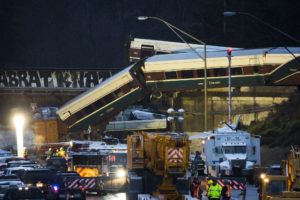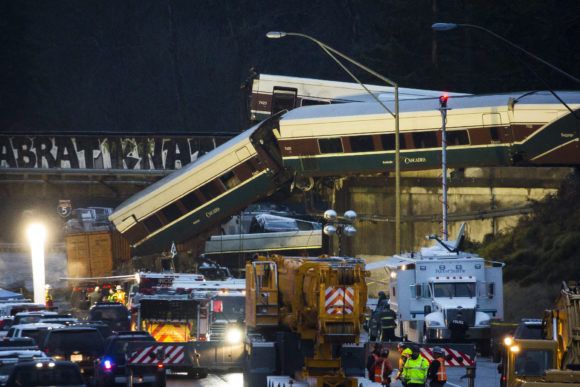The deadly Amtrak crash in Washington state marked the railroad’s third fatal accident in as many years, putting the passenger rail operator under fresh scrutiny less than a month after safety regulators issued a scathing report.
Bound for Portland, Oregon, Amtrak train 501 was traveling 50 miles per hour over the posted speed limit when it derailed Monday morning south of Seattle. Several rail cars plunged off an overpass, hitting vehicles below on the busy Interstate 5. At least three people died, 13 cars jumped the track and Governor Jay Inslee declared a state of emergency.
It was the first day that Amtrak trains were running on the Point Defiance Bypass Project, an inland route formerly owned by Berkshire Hathaway Inc.’s BNSF Railway that had been upgraded by the state for higher-speed Amtrak passenger-rail service.
“This is a brand new stretch of track, the question will be, ‘Was it designed correctly?'” said Fred Millar, an independent rail-safety consultant. “People were pretty dismayed this train could crash over the wall and into the highway.”
The National Transportation Safety Board last month decried the safety culture of Amtrak in its report into an April 2016 derailment in Chester, Pennsylvania, that killed two track workers and injured another 39 people. In a statement Nov. 14, the NTSB cited a “deficient safety management across many levels of Amtrak.”
“Amtrak’s safety culture is failing, and is primed to fail again, until and unless Amtrak changes the way it practices safety management,” NTSB Chairman Robert Sumwalt said in a statement then.
The Chester accident was one of two major Amtrak derailments in 2016. The year before, a crash in Philadelphia killed eight and injured more than 200. It was blamed on a distracted engineer. The train was traveling at more than twice the speed limit through a curved stretch of track before it derailed.
“When the NTSB gives us a recommendation, we implement their recommendations,” Amtrak President Richard Anderson said on a call with reporters after Monday’s accident. “I assure you that we take those very seriously and continue to make the investments recommended by the NTSB.”
The train that crashed Monday was traveling at 80 miles per hour in an area in which the speed limit is 30 mph, NTSB Member Bella Dinh-Zarr said at a news conference.
President Donald Trump said Monday on Twitter that the derailment shows “more than ever” why the White House’s coming infrastructure plan needs swift approval, saying, “Seven trillion dollars spent in the Middle East while our roads, bridges, tunnels, railways (and more) crumble! Not for long!”
Budget Proposal
Trump’s fiscal 2018 budget proposal, however, called for slashing Amtrak’s funding by $630 million and ending long-distance routes, citing poor on-time performance and the costs of those routes. Amtrak, which carries more than 30 million passengers a year, reported an operating loss of $227 million in fiscal 2016, on revenues of $3.2 billion.
Monday’s crash occurred on tracks owned by Sound Transit, a public-transit agency serving the Seattle metro area and the state of Washington. The states of Oregon and Washington own the Amtrak Cascades service, which runs from Eugene, Oregon, to Vancouver, Canada. Amtrak operates it as a contractor.
The overlapping ownership and operations complicates the investigation, said Deborah Hersman, chief executive officer of the National Safety Council, a private safety advocacy group.
“If it happens on the Northeast corridor on an Amtrak route with Amtrak equipment and Amtrak operating, certainly they’re going to be wholly responsible,” Hersman said. “We have to understand the full picture and it’s still to early to tell what the cause is and really assign that to anyone.”
Cars Scattered
In a low-speed crash, train cars generally still stay in line. In this case, the cars were scattered all over, former NTSB chair Mary Schiavo said in an interview on CNN.
“It looks to me like it was a high-speed event on a curve,” because the train cars were “thrown like leaves in the wind,” Schiavo said.
The investigation may review why an automated train-safety system long recommended by the NTSB wasn’t installed on the section of rail. Positive Train Control is a system that monitors other trains to prevent collisions and also ensures that a train doesn’t speed.
Train Control
The NTSB has for years pushed federal and local railroad regulators to install the train-control system to prevent accidents. It would have slowed an Amtrak train that derailed in Philadelphia in 2015, the safety board concluded.
Congress mandated the installation of the system, but pushed back the deadline to 2018 after railroads said they couldn’t meet an earlier requirement. Amtrak’s Anderson said it wasn’t active on the tracks where Monday’s accident occurred.
“This is an incredible disappointment when it comes to safety,” Deborah Hersman, former NTSB chairwoman and current president of the National Safety Council, said in an interview on CNN Tuesday. “We have got to get this technology on trains to prevent this from occurring again and again.”

The NTSB dispatched an investigative team to the scene, which occurred on the debut run of a route intended to ease congestion on tracks Amtrak shares with nearly 50 freight trains daily. The launch of public service began “after weeks of inspection and testing,” according to the Washington State Department of Transportation.
Rail accidents killed 775 people in the U.S. last year, up from 748 in 2015, according to figures from the Federal Railroad Association. Nearly 700 died in railway accidents from January through September of this year, according to the agency. The figures include deaths involving passenger, freight and commuter rails, as well as those struck by trains.
Trump’s Promise
Trump has promised to seek $1 trillion in U.S. infrastructure investment, and the White House plans to release a detailed document of principles in January for Congress to draft legislation, an administration official has said.
But the principles aren’t expected to target Amtrak or passenger rail specifically. Rather, the plan calls for allocating at least $200 billion in federal funding over 10 years from unspecified budget cuts to spur at least $800 billion in spending by states, localities and the private sector.
The bulk of the federal money would go to a pool of cash for which states and localities could apply, with preference given to those that raise taxes or find other dedicated revenue for projects, the official has said. The idea is to encourage self-help and avoid supplanting non-federal funding.
Democrats and infrastructure advocates have already complained that $200 billion is insufficient, that states and localities are already doing their fair share, and the federal government needs to be a better partner.
Senate Democrats have proposed $1 trillion in federal investment, including $50 billion to “modernize America’s rail infrastructure.” The proposal doesn’t identify a funding source.
Funding is tricky because Democrats want more federal money and Republicans don’t want deficit spending, said Republican Representative Bill Shuster, chairman of the House Transportation and Infrastructure Committee.
“We have to find a path forward that satisfies both the Democrats and Republicans,” Shuster said. “But I believe there is a path forward.”
Topics Washington Oregon
Was this article valuable?
Here are more articles you may enjoy.



 Cloudy Future for Bourbon Has Jim Beam Closing Distillery for a Year
Cloudy Future for Bourbon Has Jim Beam Closing Distillery for a Year  Aon Extends Employment Agreement With CEO Case
Aon Extends Employment Agreement With CEO Case  High-Net-Worth Risk Appetite Drops as Some Regions Show Stabilization
High-Net-Worth Risk Appetite Drops as Some Regions Show Stabilization  Howden Buys M&A Insurance Broker Atlantic Group in US Expansion
Howden Buys M&A Insurance Broker Atlantic Group in US Expansion 

